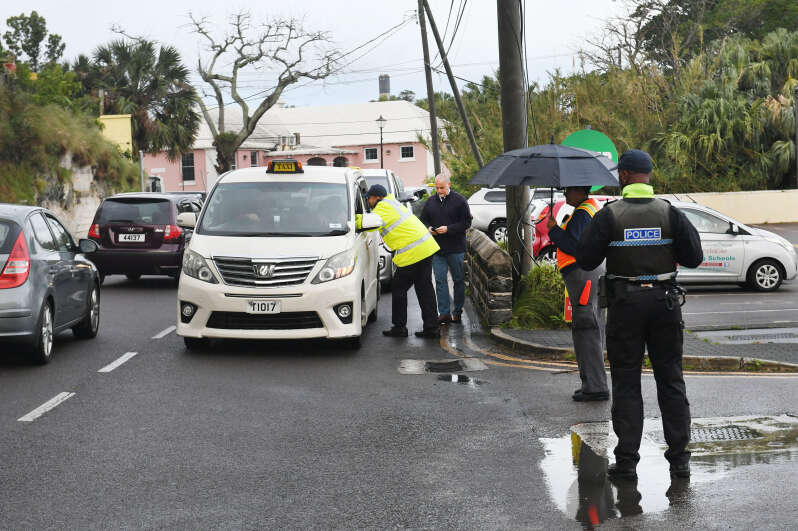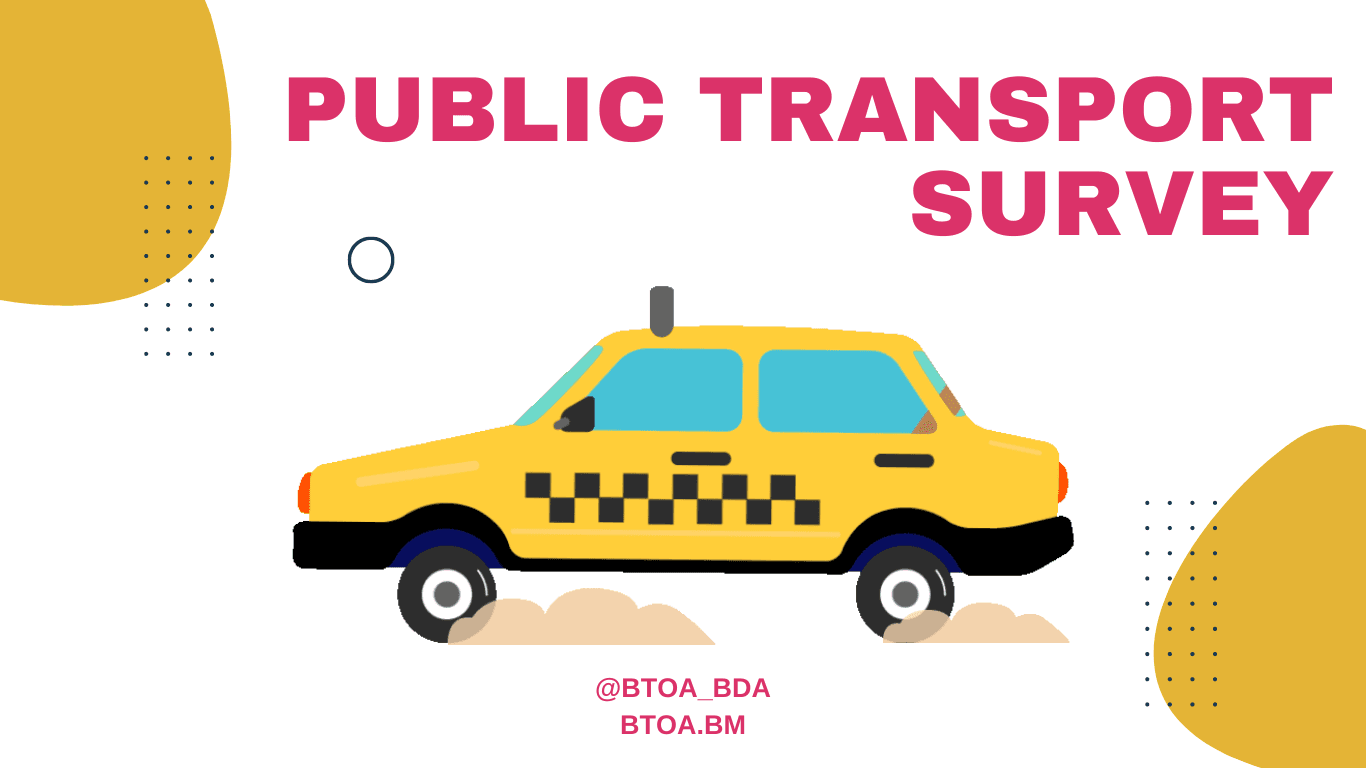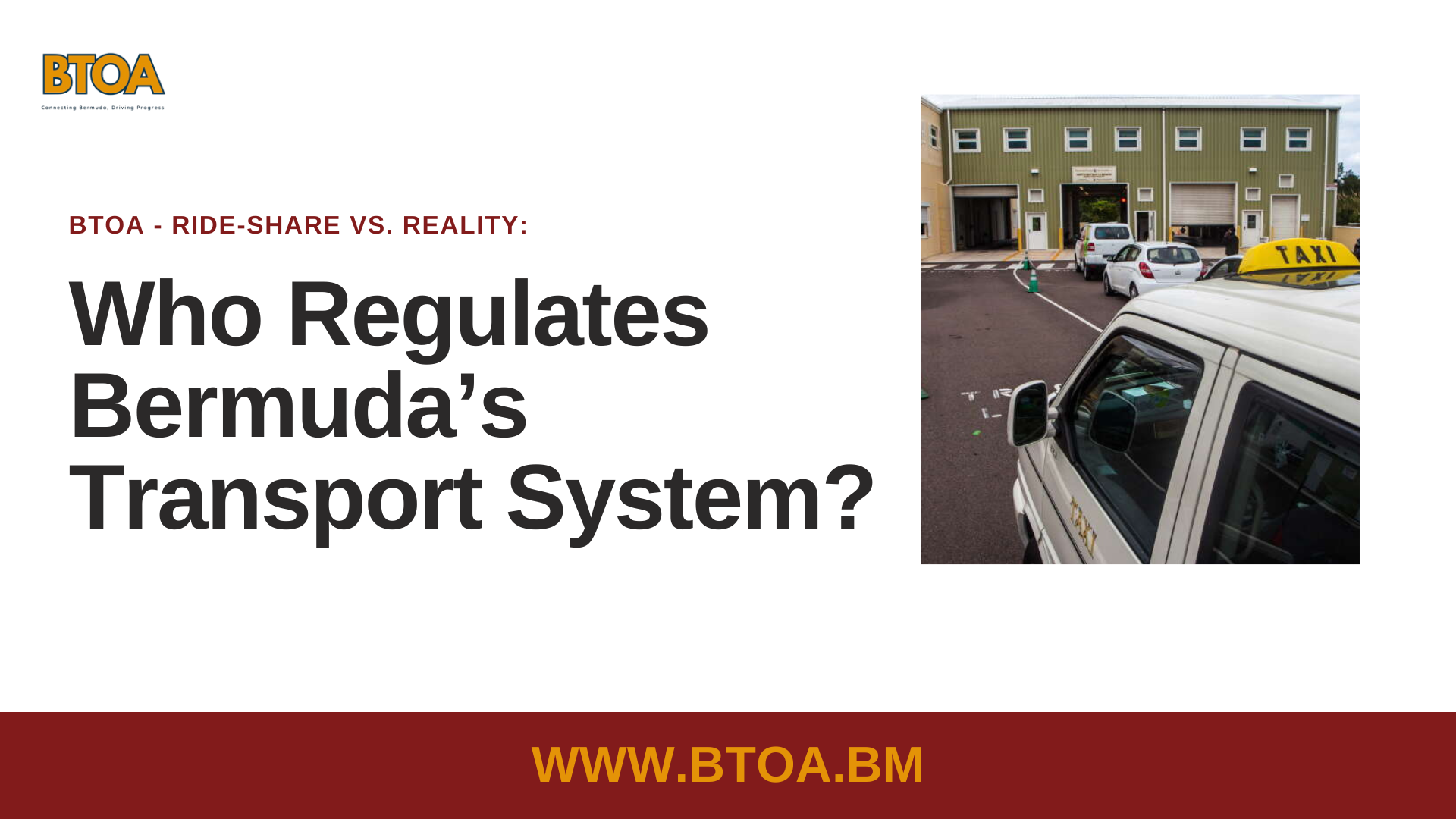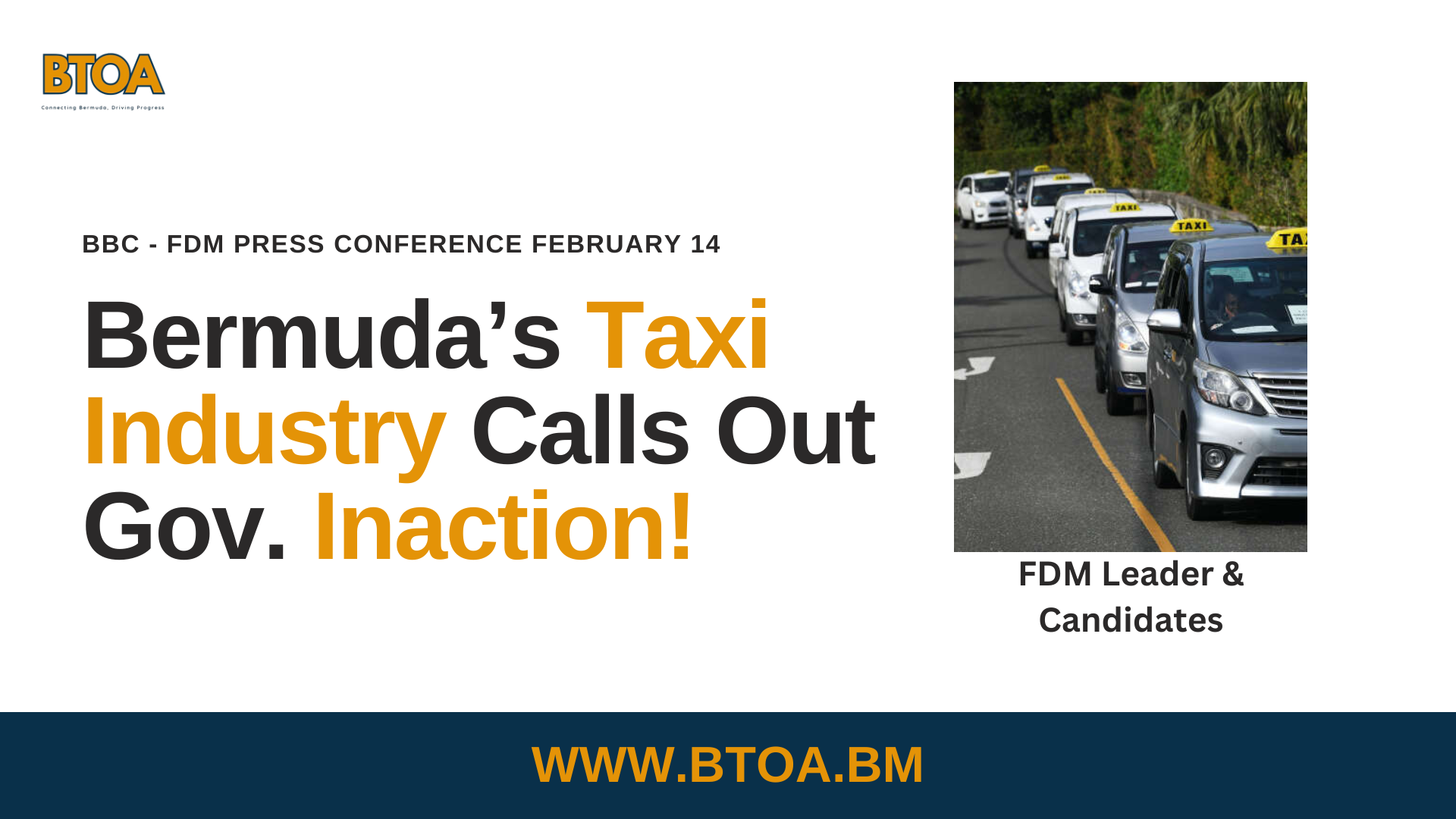“Stay with us. The truth is in the rearview, but we’re looking forward.”
Series 1 introduced how Bermuda’s taxi and transport industry grew from horse-and-buggy to a cornerstone of our tourism economy. Series 2 unpacked the laws, the agencies (TCD, PSVLB, Minister), and why enforcement is the linchpin. In Series 3, we zoom out: how do relationships between policymakers, private companies, and regulators shape what the public experiences every day? Where transparency is thin, fairness suffers. Our aim here is educational and constructive: to show where the system’s seams are and how to stitch them up.

Bermuda’s Taxi Industry
Series 3: Fractured by Design! By BTOA
The playing field: who holds which levers?
Public Service Vehicles (PSVs) include omnibuses, minibuses, motor taxis, airport taxis, and limousines. Each class requires:
- a vehicle permit (PSV permit) tied to the class of service; and
- a licensed driver vetted and tested by TCD.
TCD administers licensing, inspections, and day‑to‑day compliance tasks. PSVLB (a statutory board) issues and can suspend/revoke permits, sets categories/quotas, and hears cases. The Minister of Transport sets policy direction, signs off on regulations and category limits, and can introduce new programmes (e.g., the Ride‑Share Pilot Programme). In short, permits and enforcement live with TCD/PSVLB; policy direction and rule‑making live with the Minister.
This structure should yield checks and balances. But as we outlined in Series 2, practice has diverged from principle, especially around complaints, hours‑of‑service, and fare‑refusal enforcement.
Where ambiguity breeds imbalance
Below are pressure points where lack of transparency can tilt outcomes, sometimes unintentionally, away from fairness:
A. Permit numbers and allocations
- Caps and quotas. The number of taxi permits is finite. Decisions to raise or hold that cap, or to approve/deny transfers, have direct market impact: availability, wait times, and operator livelihoods.
- Public interest test. In theory, the PSVLB uses data (demand, service levels) to decide. In practice, data inputs are often incomplete due to inconsistent tracking on an hourly, daily, weekly, and monthly basis. GPS data and centralised performance reporting must be established and in effect.
- Perception risk. When reasons for increasing or holding caps aren’t fully published, stakeholders presume politics over policy, regardless of the truth. Disclosure reduces that suspicion.
B. Complaints and discipline pipeline
- Laws already prohibit refusal at places of hire and require minimum service availability (16 hours/day per taxi). But the complaints intake is weak, with no robust digital pathway and limited public reporting of outcomes.
- If the public can’t easily submit a complaint with a reference number and can’t see aggregated outcomes, trust erodes. Good operators suffer a reputational penalty caused by a small minority and a foggy system.
C. Dispatch, apps, and access to market
- Regulations have historically required taxis to affiliate with dispatch providers. As dispatch evolves into app platforms, platform rules become de facto market rules (who gets the call, who sees which job, fees, cash‑handling policies, etc.).
- Without clear disclosure and oversight of these platform policies, operators and customers may face hidden frictions (e.g., long waits, opaque job allocation, or inconsistent fees) that look like “industry failure” but are actually governance gaps.
D. Policy pilots in a legacy system
- The Ride‑Share Pilot Programme was designed to add after‑hours capacity via vetted part‑time operators through approved apps. Its success depends on integration with existing enforcement (same vetting, same conduct standards), data capture (so results are measurable), and clear boundaries (no street hails, proper insurance).
- If legacy enforcement (hours, refusals, complaints) remains weak, layering a new class atop an old problem can feel like substitution rather than supplementation, creating anxieties about fairness and safety.
Incentives 101: follow the flows
Markets respond to incentives, and governance sets those incentives. Consider three lenses:
1) The operator’s calculus
- Time-on-road vs. return. If law‑abiding drivers see competitors cherry‑picking or skipping hours without consequence, the fair‑play incentive collapses.
- Platform rules. If a platform penalises cash trips, or prioritises certain job types or partners, operators’ micro‑incentives shift (accept/decline patterns, preferred zones). These micro‑incentives roll up into macro outcomes: coverage gaps, peak‑time shortages, perceived “no‑show” spikes.
2) The platform’s calculus
- Volume vs. quality. Dispatch/app firms seek throughput and reliability but also manage costs and take‑rates. Choices about surge logic, queue rules, and cancellation policies materially shape public experience.
3) The policymaker’s calculus
- Visible fixes. Quick wins (e.g., a new pilot) are politically attractive. But quiet fixes (e.g., building a digital complaints stack, publishing KPI dashboards) do the heavy lifting for fairness.
When incentives aren’t aligned with compliance and service, fractures appear not necessarily by conspiracy, but by design drift. Fixing that drift requires transparent metrics and consistent enforcement.
Case window: the complaint that goes nowhere
A visitor books a taxi for 11:30 pm; no car arrives. They try the dispatch line; no luck. The next day, they can’t locate a simple online complaint form. Maybe they call TCD, but provide partial details (time, hotel, first name). No case number; no follow‑up. On social media, the story spreads.
What the law expects:
- Refusal of service at a place of hire or while plying for hire is prohibited.
- Owners are expected to ensure availability (16 hours/day), directly or through shifts.
What the system delivers:
- Weak intake, limited triage, sporadic investigation, and little public reporting.
- Result: no deterrent, no learning loop, reputational damage to compliant drivers.
What a fixed pipeline would do:
- Digital intake (web/app): standardized fields (date/time, taxi number, dispatch ref, location pin, receipt photo), auto‑issued case ID.
- Back‑office workflow at TCD/PSVLB: SLA timers, escalation rules, integration to dispatch logs/GPS.
- Outcome codes: substantiated (warning, fine, suspension), unsubstantiated (insufficient info), resolved otherwise.
- Public dashboard: monthly counts by type, average resolution time, percentage substantiated; anonymised but actionable.
This may not be glamorous, but it is essential for good governance: transparency, feedback, and consistency.
The rideshare debate: supplement or substitute?
The pilot’s stated aim is to fill after‑hours gaps through vetted, app‑dispatched drivers, with insurance and non‑hail restrictions. Reasonable on paper, if enforcement parity and data capture are real.
What needs parity:
- Vetting (PSV licence standards)
- Insurance (clear, equivalent liability)
- Conduct (same refusal rules, same complaint pipeline)
- Boundaries (no stands/hails, only app‑booked trips)
- Data (ride counts, wait times, cancellations, incidents)
What needs publication:
- The pilot rulebook (operator obligations; permitted hours/zones)
- Monthly KPI snapshots (e.g., average ETA at peak, complaint rates)
- Independent Evaluation Plan: Definition of “Success” and Criteria for Extension or Conclusion.
Absent these, stakeholders will assume the pilot substitutes for foundational fixes. With them, the pilot becomes a measurable supplement.

Transparency gaps that look like favoritism
We avoid naming individuals or speculating motives. But structurally, opaque decisions can appear like favoritism even when they are not. Examples:
- Permit transfers and waivers. If approvals/denials and their reasons aren’t logged and summarised publicly (with privacy respected), stakeholders will guess.
- Special allowances (vehicle adverts, tint, exceptional off‑road periods): when the criteria aren’t published, they look discretionary.
- Platform fee changes (cash handling surcharges, take‑rate adjustments): without published rationale and impact analysis, operators see shifting goalposts.
- Fare policy timing (e.g., fare adjustments coincident with major programme launches): without an explanatory note, the public reads linkage where there may be none.
Publish the rules of the road: criteria, processes, and annual summaries. Transparency disciplines both behavior and trust.
What good looks like: a fairness blueprint
Here is a practical, non‑partisan blueprint that aligns with the law as it stands and the industry’s real‑world needs. It’s about execution, not ideology.
A. Publish the core rulebook (one page per topic)
- Complaints: where to submit, what info is required, what happens next, and response SLAs.
- Refusals: definition, examples, penalties, how to document a refusal (e.g., stand name, time, taxi plate/badge).
- Hours of service: what counts toward 16 hours, acceptable exceptions (maintenance, medical), audit method.
- Dispatch obligations: minimum standards for platforms (audit logs, response metrics, customer support, fee disclosure).
- Pilot programmes: eligibility, boundaries, KPIs, evaluation dates.
B. Build the digital spine
- Universal complaint form with case IDs and status look‑up.
- API connections with dispatch/app logs (time stamps, accept/decline, ETA, completion).
- Secure evidence locker (photos of meters/receipts, chat transcripts) with privacy and retention controls.
- PSV dashboard with monthly public metrics (availability, median ETA, refusal complaints, substantiation rate, disciplinary outcomes).
- Open‑data policy for anonymised aggregates to support independent research and tourism planning.
C. Enforce with proportion and predictability
- Graduated penalties (warning → fine → short suspension → permit action) with published ranges.
- Randomised audits of hours and refusal complaints to deter gaming.
- Owner/driver accountability alignment so responsibility follows the actor (close the “offence follows the car” gap by rule update if feasible within current law).
D. Level the platform field
- Dispatch/app standards: publish queue logic basics, cancellation rules, fee structures, cash‑handling policies; commit to annual transparency reports.
- Parity rules: if an app handles taxis and rideshare operators, publish how jobs are routed across classes and any priority conditions (e.g., airport, accessibility vehicles etc).
- Accessibility targets: set measurable goals for accessible vehicles and publish progress.
E. Measure pilots like pilots
- Define success in advance (e.g., reduce late‑night median ETA from 25→12 minutes; complaint rate ≤ X per 1,000 trips).
- Independent evaluation: a short, published report at the pilot end with data tables and recommendations (extend, amend, sunset).
- Public Q&A: hold a debrief session where stakeholders can examine findings.
Myths, realities, and the middle ground
Myth: “If we just add more vehicles, service gets better.”
Reality: Without strong complaint intake, clear hours enforcement, and platform transparency, more vehicles can mean more noise, not more service.
Myth: “Technology solves governance.”
Reality: Apps amplify what already exists. If rules are unclear, apps amplify confusion. If rules are clear and enforced, apps amplify reliability.
Myth: “Enforcement is anti‑operator.”
Reality: Predictable enforcement protects the majority of professional operators from being undercut by a few non‑compliant actors.
What this means for each group?
For passengers:
- You should be able to book, ride, and — if needed — complain without friction.
- You should see monthly progress: wait times, complaint outcomes, and service coverage.
For operators (owners and drivers):
- You deserve a predictable rulebook and a level platform field.
- You should be able to see how your compliance and service quality translate into more work and fewer disputes.
For dispatch/app providers:
- Clear, published standards protect your brand and reduce regulatory surprises.
- Transparency about queue logic and fees builds trust with both riders and drivers.
For regulators and policymakers:
- Publishing processes and metrics reduce the perception of favoritism and strengthen legitimacy.
- A functioning complaints‑to‑discipline pipeline is the foundation on which any innovation (including pilots) can stand.
An action list we can all see
- Launch the digital complaint portal (with case IDs).
- Publish the PSV rulebook one‑pagers (complaints, refusals, hours, dispatch standards, pilots).
- Turn on monthly dashboards (availability, ETAs, complaints, outcomes).
- Adopt graduated, published penalties for refusals and hour violations.
- Require transparency reports from all dispatch/app platforms operating in Bermuda.
- Define and publish pilot KPIs and the independent evaluation plan.
- Align accountability so sanctions follow conduct (owner/driver/platform).
- Host a semi‑annual public forum (with BTA, hospitality, operators, and regulators) to review metrics and agree on adjustments.
A note on tone and intent
This series remains educational and solutions‑oriented. We recognise dedicated public servants at TCD/PSVLB and the many professional operators who carry Bermudians and visitors safely every day. Our critique is of systems and incentives, not of individuals. When the rulebook is clear, the pipeline is visible, and metrics are public, fairness follows.
Where we go from here
Fractured by Design doesn’t allege conspiracy; it diagnoses design drift and proposes a public repair manual. Bermuda can’t afford a transport system where trust is optional. We need a complaints intake that works, enforcement that is predictable, and platforms that are transparent. That is how you respect passengers, operators, and the rule of law.
Next in the Series (Series 4): Fixing the Spine — a practical, step‑by‑step blueprint to implement the complaint portal, the KPI dashboard, and platform transparency standards in 90 days, with sample screens, data fields, and an evaluation calendar.
We’re looking forward, with headlights on and the dashboard lit!





